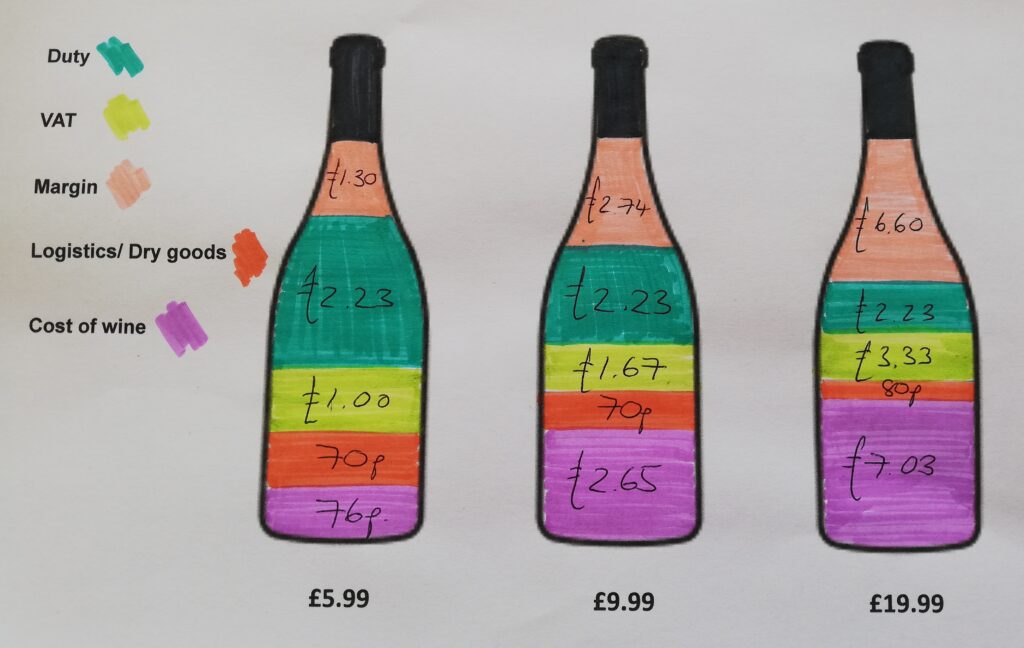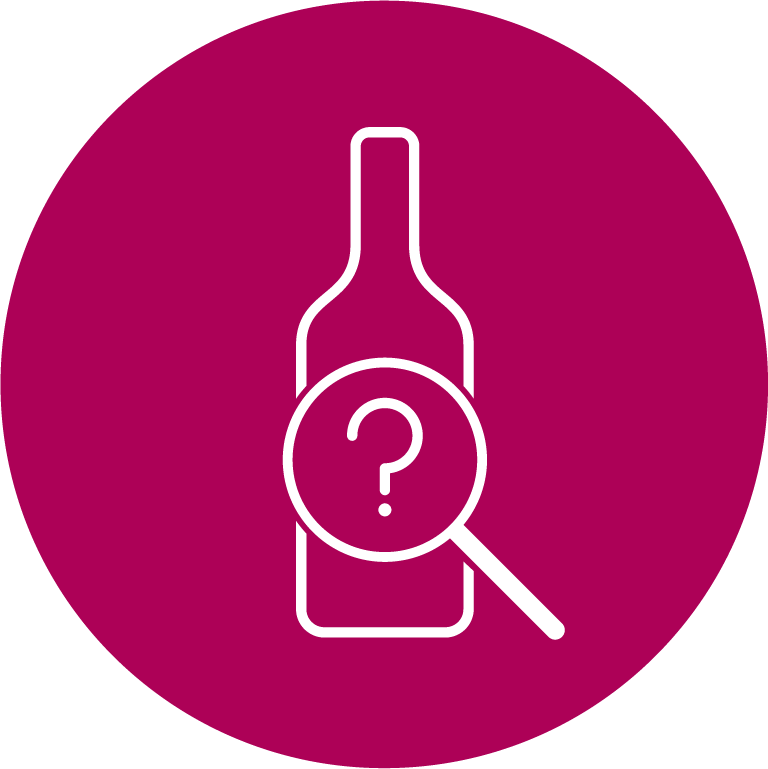It struck me that with the enormous number of outlets selling wine and the incredible range of prices on offer that it might be an interesting exercise to look at what actually makes up the price of a bottle of wine.
Before I go on, I should say, this is by no means me trying to influence how much money you should spend on a bottle – there are plenty of perfectly serviceable wines out there from the discount supermarkets for price points in the region of £6-£7, but I hope after reading this at least you know what you are getting (or not getting!) for your money, if you refuse to spend more than this on a bottle!
So what goes into making up the price of your favourite bottle of vino?
There are the various taxes (Duty and VAT), the supplier/merchant margins, the dry goods (bottle, label, cork etc), logistics (shipping costs) and finally, the cost of the wine in the bottle.
I should also say here these figures are estimates, some retailers look for bigger margins and the logistics and dry goods may vary by a few pennies depending on if the producer wants to use a heavy bottle or embossed label for example, but as a rule of thumb, these numbers give you a good idea.
Looking at the breakdown of costs for bottles at three different price points: £5.99, £9.99 and £19.99 – yes bear with me, I know that is quite a big jump in price, but there is method to the madness.
See the chart below – overlooking the rather child-like colouring in (I do apologise, art has never been a strong point of mine!), this gives an at-a-glance view of what elements account for the eventual price of a bottle of wine you buy.

The average cost breakdown for a £5.99 bottle of wine:
Yes folks, when you part with your cash for a £5.99 bottle, the wine itself accounts for about 13% of the total cost! With over 50% of the cost going on the duty and taxes. This means the winemaker is probably being squeezed on price and in order to make any money at their end, the reality is many of these wines are likely to be mass produced and overly manipulated, with less chance of any kind of sustainable/environmental considerations.
The average cost breakdown for a £9.99 bottle of wine:
See the difference in the value of the wine you are getting for the money? 3.5 times the value compared to the £5.99 bottle. I appreciate it does mean parting with a few more readies, but the quality of the liquid inside the bottle is so much better!
Note – the eagle eyed among you will have noticed that Duty is the same. This is not a typo – one thing common whether you are buying a £5.99 bottle or a £19.99 bottle is the excise duty – regardless of the price of the bottle, for a still wine (not exceeding 15% ABV and over 5.5% ABV) it is £2.23 (at least at time of writing!).
Finally, moving onto a bottle of wine costing £19.99:
At this price point, ok I acknowledge it is more than 3 times the cost of the £5.99 bottle and the reality is some of you won’t stretch to a bottle of wine at this price whatever the occasion, but the value of the wine inside it is more than 9 times higher. This means a much smaller proportion is being spent on taxes and other costs. So you see, you really do get what you (are prepared to) pay for! (see my note at the bottom on margins).
So what is the sweet spot in terms of value?
Personally, I generally spend anywhere between £12 and £25 depending on if its an everyday wine I’m looking for or a more premium one. I do go higher for special occasions like Christmas (or the hubby’s 60th birthday) but as a rule of thumb, you can get pretty damn good wines without having to break the bank in this price range.
Obviously if you love Grand Cru Burgundy or a First Growth Bordeaux, or are looking for an older vintage from a prestigious wine estate then you already know you need to part with substantially more readies than that to get what you want. But generally speaking, for those with an interest in wine, you rarely need to go much above £25 to get great wines.
Also, don’t fall into the trap of planning your purchases around the supermarket ‘discount offers’ – there is more than meets the eye with these and in my experience, rarely do you get much of a ‘bargain’!
I’d recommend looking for lesser known regions or unfashionable grape varieties (Riesling is a good example) and be prepared to be experimental, there are great wines out there and it doesn’t need to cost an arm and a leg – I will be looking at introducing some of these wines in my future mixed case offers, so stay tuned.
So there you have it, if you like bottles costing £5.99 from the High Street then that’s absolutely fine, but it is worth keeping at the back of your mind, when you take into account all the costs, what you are actually getting for your money. In my book, there is far better value to be had if you are prepared to spend a bit more but ultimately, “you pays your money and takes your choice”.
Note – One thing I am trying to do with the wines I sell, is keep margins as low as I can. I love wine and I love encouraging people to try different wines and one way I can do this is to try and make the more ‘expensive’ wines more economical to buy. I hate elitism and like to think good wine can be enjoyed by all and shouldn’t be cost prohibitive, so I do my upmost to keep the margins down to make it more accessible to everyone.

Thanks for this Sam great information